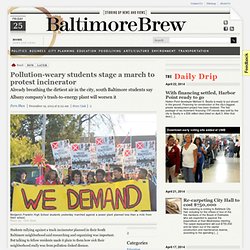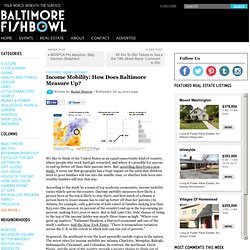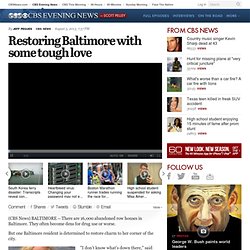

Pollution-weary students stage a march to protest incinerator. Benjamin Franklin High School students yesterday marched against a power plant planned less than a mile from their school.

Photo by: Fern Shen Students rallying against a trash incinerator planned in their South Baltimore neighborhood said researching and organizing was important. But talking to fellow residents made it plain to them how sick their neighborhood really was from pollution-linked disease. “One person said a neighbor three doors down had just died of asthma,” said Charles Graham, a senior at Benjamin Franklin High School who canvassed the streets of Curtis Bay and Brooklyn on weekends.
“We asked the students in one class how many had asthma and everyone’s hand went up!” Ben Franklin High School junior Shashawnda Campbell, a United Workers leader on the incinerator issue. Their remarks came as the students prepared yesterday for a protest march with United Workers and Unite Here Local 7. Over time, Graham said, he came to believe that he and fellow students could have an impact.
Transit. Station North. MICA. Redlining. Blighted East Baltimore land to become urban farm - Baltimore Business Journal. Kevin Litten The site at 1801 E Oliver St. is slated to become an urban farm.

The Baltimore Development Corp. board on Thursday approved a land deal with the Baltimore Food Hub initiative that will bring an extensive urban farming operation to East Baltimore. Under the deal, Baltimore Food Hub would pay the city $500,000 up front and $400,000 in a takeback mortgage for land and city-owned buildings at 1801 E Oliver St., property that is seen as a gateway to Baltimore for its proximity to train tracks used by Amtrak.
Deborah Devan, the BDC project review and oversight committee chairwoman, did not lay out details of the financial structure under the deal, citing a “confidential” document board members received. But Devan did say that city that “the developers are going to pay more than the value of the real estate,” adding, “we’re not giving the land away.” The property includes several pumping stations that used to provide water to the city. Baltimore Food Hub: $10M campus for food-related businesses, job training planned to open fall 2014 in East Baltimore [DEVELOPMENT] An ambitious $10 million plan from a group of stakeholders looks to develop two main sites for a community food entrepreneurship campus just north of Johns Hopkins Medical Campus in East Baltimore, and to have construction completed and programming and incubation for food-related businesses in place by fall 2014.
![Baltimore Food Hub: $10M campus for food-related businesses, job training planned to open fall 2014 in East Baltimore [DEVELOPMENT]](http://cdn.pearltrees.com/s/pic/th/businesses-development-65082481)
The effort, called the Baltimore Food Hub, is currently raising the funds through a combination of grants, equity, historic tax credits and new markets tax credits, said American Communities Trust Project Manager Greg Heller. The Food Hub is the sort of community redevelopment project that embraces “localism” as its keystone: encouraging economic development and growth by ensuring that there are opportunities for residents to spend their money inside the neighborhoods in which they live. (In Buffalo, a former Rust Belt city like Baltimore, this approach has been embraced by nonprofit Buffalo First.) Eastern Pumping Station Site (1801 E. Proposed economic development model. Vacant East Baltimore Property to Become Urban Farm. Baltimore Ranked Among Hardest Working Cities in America. What Is This, 2008?! Foreclosures Are Up, Way Up, in Baltimore.
In 2010, to stem the tide of foreclosures post-housing crisis, Maryland passed legislation requiring banks to seek “alternatives to eviction” before foreclosing on a borrower.

And that legal dam held back foreclosures for a couple years. But now banks have broken through and properties “getting default, auction, and repossession notices” are on the rise — big time. Foreclosures in Baltimore are up 182 percent from last July at the same time that they’ve dropped 32 percent nationwide. And Maryland’s foreclosure rate last month was second only to Florida. And it’s not like we weren’t one of the hardest-hit cities the first time around. And in case you thought there was a silver lining, there may not be. Read more about this at Bloomberg. Income Mobility: How Does Baltimore Measure Up? We like to think of the United States as an equal-opportunity kind of country, where people who work hard get rewarded, and where it’s possible for anyone to end up better off than their parents were.

But, according data from a new study, it turns out that geography has a huge impact on the odds that children born to poor families will rise into the middle class, or whether kids born into wealthy families will stay that way. According to the study by a team of top academic economists, income mobility varies widely across the country. (Income mobility measures how likely a person born at the top is likely to stay there, and how much of a chance a person born to lesser means has to end up better off than her parents.) In Atlanta, for example, only 4 percent of kids raised in families making less than $25,000 (the poorest 20 percent of the country) end up in the top-earning 20 percent, making $107,000 or more.
Baltimore City Power Rankings - News and Features.
Baltimore publications. Powerful People in Baltimore. Harbor Point Development. Restoring Baltimore with some tough love. (CBS News) BALTIMORE -- There are 16,000 abandoned row houses in Baltimore.

They often become dens for drug use or worse. But one Baltimore resident is determined to restore charm to her corner of the city. "I don't know what's down there," said Carol Ott. CBS News met Ott on the east side of town. Poverty in the suburbs: Hidden and growingCensus data: Half of U.S. poor or low incomeDetroit residents worry about their future after city declares bankruptcy "It's crazy, you are standing basically in what amounted to at one time a vibrant active community and now it's just a wasteland at the corner of North Bethel and Lansing street," said Ott. Ott believes a lot can be said about a city with many vacant homes. "It says no one cares, you are not worth of our attention time or money," said Ott. She says she's had contact from the owners.
Cool Revolution.